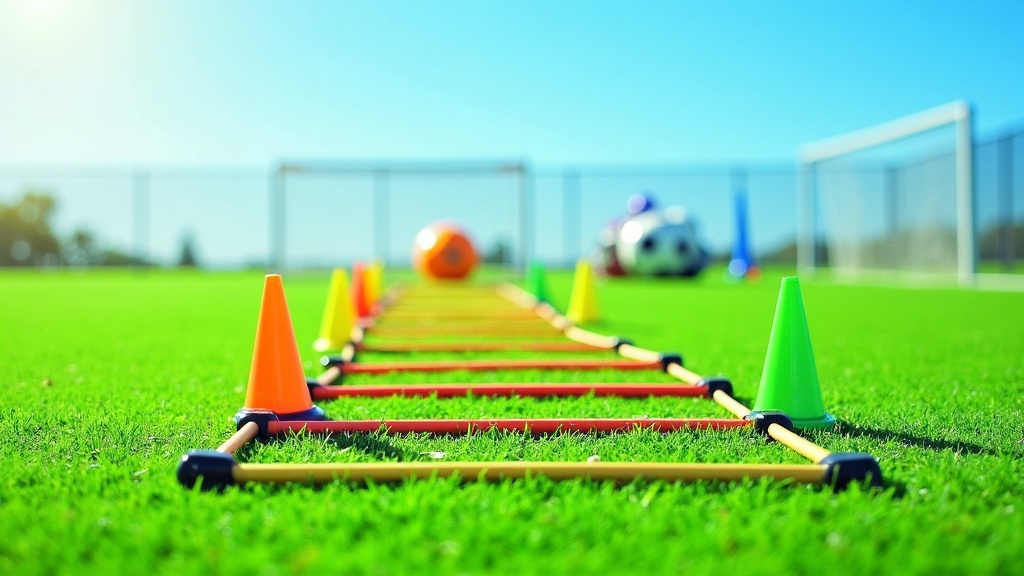Building agility is a top way to give your soccer game a boost, especially if you want to dodge defenders and create more attacking chances. An agility ladder is a simple but super useful piece of equipment for sharpening your footwork, improving speed, and training your mind to react quicker on the pitch. There are countless agility ladder drills out there, but these seven are my go-to for helping players move quickly, change direction on a dime, and break through a defense.

Why Agility Matters for Soccer Players
Soccer moves fast, and you can’t just rely on top speed or brute strength. Agility quickly separates players who can just keep up from those who make a real impact. Agility in soccer means being able to accelerate, decelerate, and change directions without losing balance or control.
Good agility helps you sneak past defenders, make sudden stops to shake off a marker, or recover quickly after a missed pass or loose ball. It helps every position—wingers looking to take on fullbacks, midfielders searching for space, and defenders keeping up with tricky opponents. Smart agility ladder drills target these areas and build real confidence on the ball.
What to Know Before Getting Started
You don’t need fancy gear to work on your agility. An agility ladder, a little bit of space, and comfortable shoes are enough. On grass, it helps to secure the ladder down so it doesn’t slide around during drills. Before you get going, take five minutes to warm up by jogging lightly and stretching, which keeps injuries at bay and gets your muscles ready for fast moves.
If you’re new to agility ladders or returning to training after a break, start slowly. Focus on getting the rhythm and foot placement locked in before pushing your speed. You’ll unlock a lot more from these drills when you first build a solid foundation, and you’ll naturally get faster as your technique improves. CHECK OUT MORE: DO WANNA START YOUR OWN ONLINE
7 Soccer Agility Ladder Drills to Boost Your Game
These ladder drills are perfect for solo training, team warm-ups, or slotting into any soccer workout. Each drill should last about 30-45 seconds, followed by a 30-second rest. Cycling through all seven for one or two rounds gives you a sweet agility session.
- In and Outs (Two Feet In, Two Feet Out):
Standing at one end of the ladder and facing forward, step into every square with both feet (left then right), then step out to either side before advancing. This builds fast, light steps and quick sideways moves, which is key in weaving through tight spots in the midfield. - Singleleg Hops:
Hop down the ladder on one leg, hitting each square. When you reach the end, switch legs and go back. This drill challenges your balance and lower body power. Working singleleg control is essential for preventing injury and gaining stability. - Lateral Shuffle through the Ladder:
Face sideways to the ladder and shuffle both feet quickly into each square as you move down. This drill keeps your hips low and your movements sharp—handy for tracking opponents and making sudden turns while staying balanced. - Icky Shuffle:
This is about groove and coordination. Start with your right foot into the first square, bring in your left, then move your right foot outside the ladder. Lead with your left into the next square, join with your right, then have your left go outside. Repeat the pattern. The Icky Shuffle gets your feet moving fast and improves rhythm, helping you react to a defender’s challenge. - Forward Backward Sprints:
Step forward three ladder squares, then move back one, repeating down the length. This switch between forward and backward movement trains your ability to adjust quickly—great for both defenders and wingers. - Zigzag Runs:
Instead of straight steps, start by putting your right foot into the first square, then cross over to diagonally step into the next square with your left. Keep zigzagging down the ladder. This pattern helps your feet cross over each other, pushing you to move outside your normal comfort zone, perfect for faking out defenders. - Crossover Steps:
Start at the left side of the ladder. Step your right foot over and into the first square, then bring your left foot in after. Keep crossing your outside foot over into the next squares, then switch sides for the return. This move is clutch for hip mobility and lets you make sharp, directional changes, a real weapon in one-on-one situations.
Tips for Getting the Most Out of Agility Ladder Drills
- Start Slow, Then Speed Up: Trying to rush before learning the footwork usually leads to mistakes. First, get the movements down, then amp up the pace as you get more confident.
- Focus on Technique: Stay on your toes, swing your arms easily, and keep your eyes up—just like playing for real. Perfect form builds strong muscle memory for game day.
- Rest is Important: Don’t skip your rests. Quick breaks help reset your coordination and keep you sharp, so you avoid sloppy steps from fatigue.
- Mix It Up: Want to make things harder? Bring in a soccer ball and dribble through the ladder or catch quick passes from a friend after each drill. By mixing in ball work, you make things closer to real play and keep things fresh.
Common Challenges and How to Get Past Them
- Losing Balance: If you’re wobbling or feeling shaky, ease up on speed and use your arms for more balance. Your stability will grow as you gain strength.
- Tripping Over the Ladder: Everybody trips up sometimes. Lift your feet and pay attention to each step. If you mess up, reset and go again. Improvement only comes with steady practice.
- Getting Bored: Repeating moves can get dull. Challenge yourself by beating your best time or introducing a new drill whenever you feel ready. Small goals keep you motivated.
Why Singleleg Drills Matter
Lots of soccer moves—cutting, sprinting, and leaping—happen off one leg. Adding singleleg ladder drills to your routine helps with injury prevention and builds even strength across both sides of your body. I add these regularly, especially after feeling a twinge or if I’m rehabbing from a minor tweak.
When to Use Agility Drills in Training
Agility ladder drills work great as a warm-up, especially before high-intensity skills or a scrimmage, since they wake up your fast-twitch muscles. They can also go in right after ball skills for a nice change of pace. You only need 10-15 minutes on the ladder a few times a week to notice your movement gets crisper and your reactions sharper.
Other Simple Equipment to Mix In
If you want to take your ladder sessions up a notch, cones, small hurdles, and resistance bands are easy to use and inexpensive. These give a boost to your sessions and help create different speed and strength demands.
- Cones: Use cones to mark new stepping points or add reaction zones at either end of your ladder.
- Mini Hurdles: Try jump training between ladder patterns or work on plyometrics for more explosive movement.
- Bands: Add a resistance band around your legs to load up your muscles and finish your stability training on a high note.
Frequently Asked Questions
Do I need a fancy agility ladder?
Nope. Basic plastic ladders do the trick, and a chalk outline works fine for backyard sessions.
How often should I do these drills?
Two or three times a week is enough to see progress without overworking your muscles or risking burnout.
Will these ladder drills help with other sports?
Absolutely! Any sport with fast footwork and sudden moves—like tennis, basketball, or even football—will benefit from agility ladder work.
Ready to Blow Past Defenders?
Jumping into agility ladder drills is one of the easiest ways to give your soccer skills a quick boost. Stay consistent, challenge yourself to make progress, and you’ll find dodging players and getting open for a key pass feels a lot easier. Stick with these seven drills, stay sharp, and set yourself up to shine every time you run out on the pitch.

